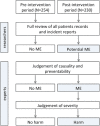Medication audit and feedback by a clinical pharmacist decrease medication errors at the PICU: An interrupted time series analysis
- PMID: 30623062
- PMCID: PMC6200092
- DOI: 10.1002/hsr2.23
Medication audit and feedback by a clinical pharmacist decrease medication errors at the PICU: An interrupted time series analysis
Abstract
Objective: Medication errors (MEs) are one of the most frequently occurring types of adverse events in hospitalized patients and potentially more harmful in children than in adults. To increase medication safety, we studied the effect of structured medication audit and feedback by a clinical pharmacist as part of the multidisciplinary team, on MEs in critically ill children.
Method: We performed an interrupted time series analysis with 6 preintervention and 6 postintervention data collection points, in a tertiary pediatric intensive care unit. We included intensive care patients admitted during July to December 2013 (preintervention) and July to December 2014 (postintervention). The primary endpoint was the prevalence of MEs per 100 prescriptions. We reviewed the clinical records of the patients and the incident reporting system for MEs. If an ME was suspected, a pediatrician-intensivist and a clinical pharmacist determined causality and preventability. They classified MEs as harmful according to the National Coordinating Council for Medication Error Reporting and Prevention categories.
Results: We included 254 patients in the preintervention period and 230 patients in the postintervention period. We identified 153 MEs in the preintervention period, corresponding with 2.27 per 100 prescriptions, and 90 MEs in the postintervention period, corresponding with 1.71 per 100 prescriptions. Autoregressive integrated moving average analyses revealed a significant change in slopes between the preintervention and postintervention periods (β = -.21; 95% CI, -0.41 to -0.02; P = .04). We did not observe a significant decrease immediately after the start of the intervention (β = -.61; 95% CI, -1.31 to 0.08; P = .07).
Conclusion: The implementation of a structured medication audit, followed by feedback by a clinical pharmacist as part of the multidisciplinary team, resulted in a significant reduction of MEs in a tertiary pediatric intensive care unit.
Keywords: ITS; PICU; harm; medication error; multifaceted intervention; pharmacist.
Figures
Similar articles
-
A study of medication errors during the prescription stage in the pediatric critical care services of a secondary-tertiary level public hospital.BMC Pediatr. 2020 Dec 5;20(1):549. doi: 10.1186/s12887-020-02442-w. BMC Pediatr. 2020. PMID: 33278900 Free PMC article.
-
Effects of the implementation of a preventive interventions program on the reduction of medication errors in critically ill adult patients.J Crit Care. 2013 Aug;28(4):451-60. doi: 10.1016/j.jcrc.2012.11.011. Epub 2013 Jan 18. J Crit Care. 2013. PMID: 23337487
-
Medication errors in pediatric inpatients: a study based on a national mandatory reporting system.Eur J Pediatr. 2017 Dec;176(12):1697-1705. doi: 10.1007/s00431-017-3023-8. Epub 2017 Oct 1. Eur J Pediatr. 2017. PMID: 28965285
-
From basic to advanced computerised intravenous to oral switch for paracetamol and antibiotics: an interrupted time series analysis.BMJ Open. 2022 Apr 8;12(4):e053010. doi: 10.1136/bmjopen-2021-053010. BMJ Open. 2022. PMID: 35396281 Free PMC article. Review.
-
Impact of pharmacist interventions on medication errors in hospitalized pediatric patients: a systematic review and meta-analysis.Int J Clin Pharm. 2020 Aug;42(4):979-994. doi: 10.1007/s11096-020-01034-z. Epub 2020 Apr 24. Int J Clin Pharm. 2020. PMID: 32328958
Cited by
-
Audit and feedback interventions involving pharmacists to influence prescribing behaviour in general practice: a systematic review and meta-analysis.Fam Pract. 2023 Dec 22;40(5-6):615-628. doi: 10.1093/fampra/cmac150. Fam Pract. 2023. PMID: 36633309 Free PMC article.
-
Use of dornase alfa in the paediatric intensive care unit: current literature and a national cross-sectional survey.Eur J Hosp Pharm. 2022 May;29(3):123-128. doi: 10.1136/ejhpharm-2020-002507. Epub 2020 Oct 29. Eur J Hosp Pharm. 2022. PMID: 33122405 Free PMC article.
-
Interventions to Reduce Pediatric Prescribing Errors in Professional Healthcare Settings: A Systematic Review of the Last Decade.Paediatr Drugs. 2021 May;23(3):223-240. doi: 10.1007/s40272-021-00450-6. Epub 2021 May 7. Paediatr Drugs. 2021. PMID: 33959936
-
Satisfaction and needs of pharmacists in prescription-checking training: a cross-sectional survey.J Int Med Res. 2020 Nov;48(11):300060520965810. doi: 10.1177/0300060520965810. J Int Med Res. 2020. PMID: 33131364 Free PMC article.
-
Impact of a Bundle of Interventions on the Spectrum of Parenteral Drug Preparation Errors in a Neonatal and Pediatric Intensive Care Unit.J Clin Med. 2024 Oct 11;13(20):6053. doi: 10.3390/jcm13206053. J Clin Med. 2024. PMID: 39458002 Free PMC article.
References
-
- Zegers M, de Bruijne MC, Wagner C, et al. Adverse events and potentially preventable deaths in Dutch hospitals: results of a retrospective patient record review study. Qual Saf Health Care. 2009;18:297‐302. - PubMed
-
- Choi I, Lee S, Flynn L, et al. Incidence and treatment costs attributable to medication errors in hospitalized patients. Res Social Adm Pharm. 2016;12:428‐437. - PubMed
-
- Glanzmann C, Frey B, Meier CR, Vonbach P. Analysis of medication prescribing errors in critically ill children. Eur J Pediatr. 2015;174:1347‐1355. - PubMed
LinkOut - more resources
Full Text Sources
Miscellaneous



